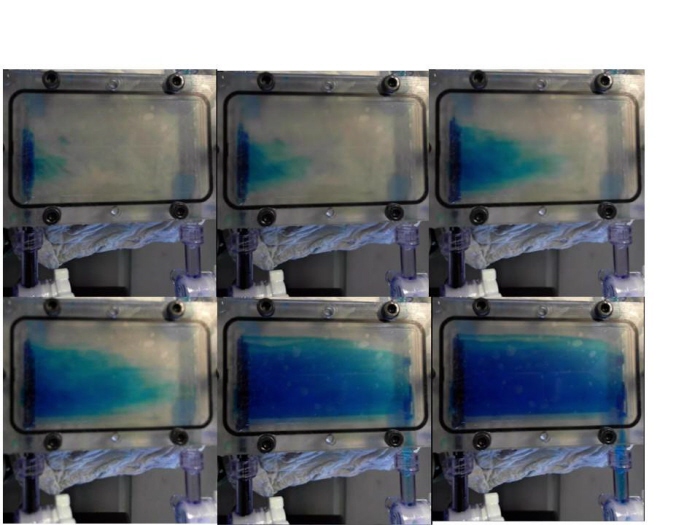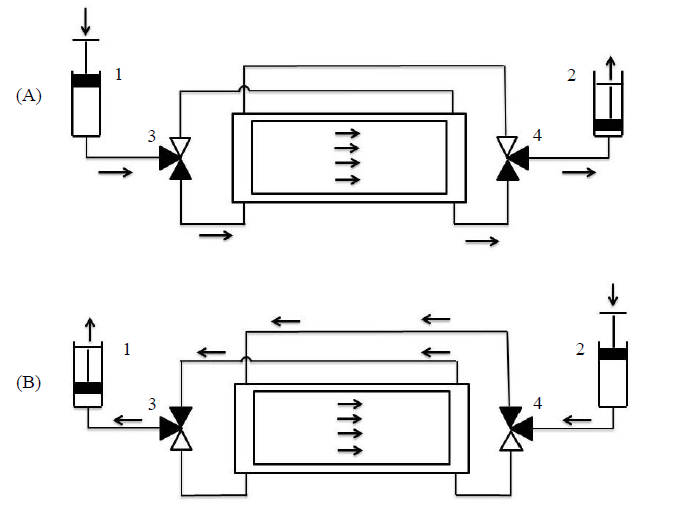
A Parallel Plate Flow Chamber (PPFC) is a device used to apply shear stress to a monolayer of cells by passing fluid across a layer of cells on a glass slide. A very narrow gap between the plates helps maintain a homogenous flow. To date, many PPFC designs apply unsatisfactory shear stress inhomogeneity or induce unwanted physiologically significant levels of pressure. This report investigated methods of improving wall shear stress homogeneity and reducing pressures in the chamber. A PPFC was designed, fabricated and tested both experimentally and using computational fluid dynamics software (Star CCM+). The design was found to have a high level of shear stress homogeneity but also high pressure levels which may be physiologically relevant. Methods for reducing the mean pressure in the chamber were recommended and a novel design capable of applying fluid induced shear stress and hydrostatic pressure simultaneously, or individually, was presented.

Figure 1: Labelled section through the Base of the PPFC; (1) inlet reservoir, (2) inlet slot (3) channel depth of 0.2 mm, (4) 2 mm wide lip to seat glass slide, (5) channel for holding a rubber seal (6) 8 x M4 threaded holes to hold the cover (7) gap to aid slide removal.
Existing PPFC were researched and a design was created that incorporated the best features of all the existing chambers. Additional features for ease of use were a thumb catch for removing the glass slide and recessed cover that allows for easy allignment of the thumb screws.

The two most important equations governing the fluid flow in the chamber are for shear stress (Eq. 1) and the Reynolds number (Eq. 2). These show that by minimizing the height between the parallel plates that: the required flow rate for a given shear stress can be minimized and that the Reynold's number is also minimized.

Figure 2: Shear Stress values across the test area.
CFD analysis was completed using Star CCM+. Many different geometry variations were considered and the final design was analyzed for shear stress homogeneity, pressure variations and flow direction. A small are of low flow rate occurs at the corner of the test area nearest the inlet. This is due to the fluid's momentum carrying it to the outside of the bend. The affected are was determined to be insignificant compared to the size of the test area.

Figure 3: Streamline velocities through the final design.
An important consideration was that all the fluid flows straight and parallel to the side walls of the chamber. This ensures that the cells are all experiencing unidirectional, homogenous shear stress.

Figure 4: The PPFC was tested to determine usability and check for any leaks.

Figure 5: Dye tracking experiment.
A dye tracking experiment was carried out to corroborate the CFD results. Mixing in the settling chamber made following the dye front difficult but was sufficient to calculate approximate shear stresses.

Figure 6: Novel double syringe pump configuration
A novel design for a PPFC capable of applying fluid induced shear stress and quantifiable pressure was proposed. Two actuators and two three-way valves are used to provide a lot of flexibility for when applying mechanical stimuli. This allows fluid induced shear stress and pressure to be applied simultaneously, independently and individually.
gLike